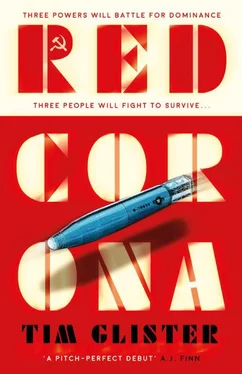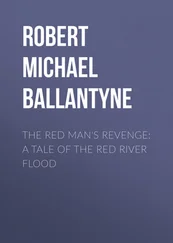Holland was watching out for any high-ranking officials the camera might catch. White was soaking up as much information as he could from the control boards the camera drifted over – he wondered how much of the technological spectacle was for show, a flickering metal curtain hiding a hundred invisible mathematicians frantically crunching numbers. And Knox was looking for one person in particular. Then for one brief moment he saw her.
Irina Valera. The woman who had almost killed him twelve months ago was standing at the back of the room, staring up at something Knox couldn’t see. She looked calm. Her face was unreadable – if she felt anything about what was happening in front of her, she wasn’t showing it. A phantom pang of pain shot through his chest.
Knox also recognised the man standing next to Valera. It was Dixon, the head of the Corona project and one of the two men who had persuaded Valera to get on a plane to America a year ago. He thought about Bennett, and if she was watching the broadcast somewhere, maybe crammed into a room as full as Holland’s office with her fellow trainee CIA field agents.
The camera only lingered on Valera and Dixon for a few seconds before it cut away again, this time to the White House and an empty dais bearing the presidential seal and flanked by American flags. The big moment had finally come. Kennedy walked into shot and Holland’s office fell silent again.
He took to the stage and immediately began his address, his speech punctuated with his trademark ‘err’s and pauses.
‘I understand that part of today’s press conference is being relayed by the Telstar communications satellite to viewers across the Atlantic,’ he said. ‘And this is another indication of the extraordinary world in which we live.’ Mocked-up footage of the satellite spinning in space then came on the screen. ‘The satellite must be high enough to carry messages from both sides of the world, which is of course a very essential requirement for peace,’ he continued, as the camera switched back to him. ‘And I think this understanding which will inevitably come from these speedier communications is bound to increase the well-being and security of all people, here and those across the oceans.’
It was a casual, relaxed performance but the words had been very carefully chosen, and Kennedy’s message was clear.
He went on to talk about the price of the American dollar, which had been a rumbling news story across Europe for the last few weeks. However, Knox didn’t hear any of that. He was too busy thinking about the president’s opening remarks and the presence of Irina Valera at the heart of the Telstar project.
Telstar had been pitched as the newest triumph of innovation driven by America’s dual belief in itself and limitless budgets. But as far as Knox was concerned, that’s not what Telstar was at all. It was a public relations exercise, a dazzling piece of propaganda beamed directly into millions of households up and down Britain, and even more across Europe and America. He wondered what Khrushchev would have said if he was the one behind the podium, being broadcast to the world.
Telstar was something for the public to be wowed by and for governments and intelligence agencies to pay close attention to. It was also a cover. Kennedy’s comments about international security and seeing Valera at Cape Canaveral had given it away. Even with an unlimited budget there was no way the US would have invested millions in breaching the atmospheric barrier for a relay satellite that worked for less than three hours a day.
Knox was willing to bet that the next generation of Corona satellites was already in orbit, sending everything they spotted straight to the watchful eyes of the CIA. Some people in Holland’s office would probably think that was a good thing. Knox wasn’t so sure.
At the end of the broadcast the collected department heads started to chat again, alternating between how impressed or underwhelmed they were seeing America’s greatest living orator speak live for the first time. Knox, White, and Holland, who had all paid closer attention to what the president had actually said, remained silent.
After a few minutes, Holland sat down at his expansive and fastidiously clear desk, signalling that it was time for everyone to get out.
‘Did you notice?’ Knox asked Holland after everyone except he and White had left.
‘We shouldn’t be too surprised,’ Holland responded. ‘And now at least we know for certain.’
‘What can we do?’
‘We can do nothing.’ Holland turned to White. ‘Though it might perhaps be time to bring Six in on Pipistrelle and see what they come up with.’
White didn’t look thrilled at the prospect, but he had also caught sight of Valera and could read between Kennedy’s lines.
‘Are you sure that’s wise?’ he asked.
‘Total secrecy appears to be a luxury we can no longer afford,’ Holland replied. ‘And neither is paranoia. We have to trust someone, and it may as well be our own.’
‘I’m sure the Americans would never dream of pointing one of their satellites at us,’ Knox said. ‘But it would be nice to get a little warning if they did.’
‘Quite,’ Holland responded.
‘I’ll arrange a meeting,’ White said. Then he took his leave, followed almost immediately by Knox.
The conversations continued out in the hallway, but Knox didn’t join in with them. Instead, he headed straight to his office.
He shut the door behind him, sat down, and briefly cast his eyes over the reports that had been left on his desk for him to review. He thought again about Bennett, about discovering her in his kitchen, and the vision of a whole planet living under total surveillance that had scared her so much. He’d humoured her to begin with, then he started to share her concerns. Now he had the uncomfortable feeling that he’d just witnessed them take a very large step towards becoming reality.
He wanted to know if Bennett felt more terrified now, or relieved that at least it was her own government bringing her darkest fears to life. He also wanted to know if Valera was pleased with what she’d helped unleash on the world. But those were questions he couldn’t ask either of them.
Knox got up, removed a bottle of ten-year-old Ardbeg single malt whisky and a crystal glass from the low teak cabinet that ran the length of his office, and poured himself a drink. Then he stood at his window as the whisky sat untouched on his desk, looked out over the roofs of the city, and wondered if someone high above was looking down on him.
The Cold War science and technology in Red Corona may seem fantastical, but it’s all real. Or at least based in fact.
The sixties was an intense period of innovation in this arena, driven in equal parts by ambition and paranoia. For several years the Corona programme was the apex of global surveillance, complete with parachutes and giant hooks. And ever-more-sophisticated listening devices were constantly being created by intelligence agencies all over the world, though Pipistrelle and Atlas brings a few major developments in that sphere forward by a few years.
But it wasn’t just the West that was coming up with new ways to spy on people from the stars or through walls. For most of the sixties, the USSR led the space race. Russia even had their own version of Corona called Zenit (codenamed Kosmos), which was only decommissioned in 1994. The Soviet naukograd system of closed cities is also well-documented, and both Kupriyanovich’s mobile phone and the BIOS-3 sealed ecosystem were real.
There’s no proof of any connection between the Corona programme and the Telstar communications satellite. But, as they were developed so close to each other, and represented a step-change evolution of the same technology, it’s compelling to speculate that there might have been a link.
Читать дальше












